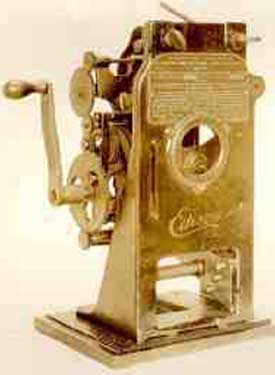Part 4:
Even More Films by Edwin S. Porter of the Kinetoscope Era
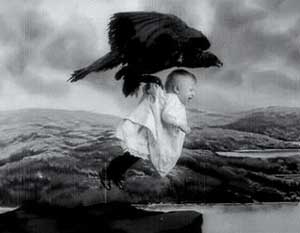 A woodsman (played by D. W. Griffith!) sets out to work, with a lunch box from his wife who, holding their infant, watches him set out to join his crew of lumberjacks.
A woodsman (played by D. W. Griffith!) sets out to work, with a lunch box from his wife who, holding their infant, watches him set out to join his crew of lumberjacks.
There follows in Rescued from an Eagle's Nest (1908) a scene of the men bringing down a tree, before we cut back to the woodsman's cabin, where a big black eagle swoops down & carries away the infant.
The mother runs out of the house seeing the eagle flying away. She rushes in the house to get her hat then off to find her husband & tell him what happened. She & all the lumberjacks set off in search of the eagle's nest, which is halfway down the sheer wall of a cliff.
The woodsman is lowered to the nest on a rope. When attacked by the bird, he has quite a battle on the dangerous ledge, finally strangling it & beating it with a stick. Grabbing up his baby, he tugs the rope & the other men pull them to safety.
An absoluktely wonderful little film. The image of the articulated eagle flapping its wings & flying off with the baby is one of the first truly immortal images in the cinema. The fight on the ledge is thrilling. And of course we learn how important it is, if an eagle gets your baby, never forget your hat.
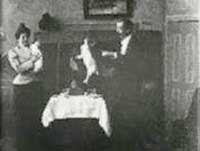 A comedy probably based on a vaudeville routine, An Animated Luncheon (1900), a companion piece to J. Stuart Blackton's A Mysterious Cafe (1901), opens with a well-dressed man & woman arriving at a restaurant & being seated by the aproned waiter at a small table.
A comedy probably based on a vaudeville routine, An Animated Luncheon (1900), a companion piece to J. Stuart Blackton's A Mysterious Cafe (1901), opens with a well-dressed man & woman arriving at a restaurant & being seated by the aproned waiter at a small table.
Most such films would've placed the table dead-center on the set, but this is more artfully off-center, with a picture hung on the wall at the center to underscore the off-centeredness of the meal about to get out of hand.
The waiter circles the table & the first odd moment is how he manages to hang their hats on each side the painting. He then brings them hard boiled eggs but when they crack open the eggs, ducks spring forth & fly away. The second course is cheese fondu (Welsh rarebit), & soon the diners must remove white rabbits from the table (embracing a pun for rarebit & rabbit).
The diners stand up & take the rabbits from the table, placing them on the floor to wander about at will. The gentleman bangs the table with his fist, as though just a bit annoyed. It's quite an imaginative strange film, with smoothly done trick photography.
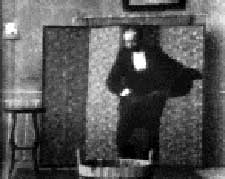 Ching Ling Foo Outdone (1900) is another trick film, this one presenting a standard-issue magician who stands before a folding screen.
Ching Ling Foo Outdone (1900) is another trick film, this one presenting a standard-issue magician who stands before a folding screen.
He holds out a black cloth, then moves it away & has materialized a wooden washtub full of water. Covering the tub with the cloth for a moment, he materializes ducks in the water. Covering the tub again, it vanishes to be replaced by a small child.
There's nothing at all here to explain the title, but audiences of the day would know that Ching Ling Foo (nee Chee Ling Qua) was one of the most famous magicians of the day, & the first Chinese magician to achieve broad success in Europe & America. His most famous trick "The Mystic Cauldron" involved materializing a basin out of which he removed a young boy.
D. W. Griffith's future cinematographer G. W. "Billy" Bitzer made Ching Ling Foo the subject of A Farmer's Imitation of Ching Ling Foo (1900), in which a geezer holds up a quilt in order to materialize a girl in bloomers on bicyle, holds up the quilt again to turn the girl into a donkey, & a third time to produce three girls.
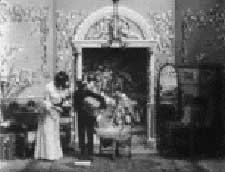 The ornate set for The Messenger Boy's Mistake is a lady's parlor. A young woman receives a package from a messenger-boy, together with a note that reads, "My dear Maud. If you love me, wear the enclosed when I call this evening. Yours lovingly, Harold."
The ornate set for The Messenger Boy's Mistake is a lady's parlor. A young woman receives a package from a messenger-boy, together with a note that reads, "My dear Maud. If you love me, wear the enclosed when I call this evening. Yours lovingly, Harold."
She opens the box after the boy leaves, & is horrified. When Harold shows up, she gives him an angry talking-to about the undergarments he sent her. Suddenly the messenger boy returns to fetch back the package, & deliver the right one, which contains only a corsage of flowers. All's well that ends well!
An interesting touch to the set design is the tall mirror arranged at an angle so as to reflect only what appears on the set.
The acting is also done for the sake of realism rather than the often scene vaudevillian exaggeration, as though the filmmakers & performers were learning that viewing a film in a kinetoscope was an intimate close-up experience, & no need to pitch it to the peanut gallery.
Casts are rarely named in these short-short films but the messenger boy was played by Gilbert M. 'Broncho Billy' Anderson, & though he looked like a child he was in fact twenty-three when he played that role.
Anderson was a friend of Edwin S. Porter, who met him while filming vaudeville acts. He was soon making appearances in Porter films & even helped write the scripts. He plays three roles in The Great Train Robber (1903), including the "tenderfoot dancer." He eventually directed his own films, & would become well-famed as the first cinematic cowboy hero Broncho Billy. Still later he produced films starring Stan Laurel.
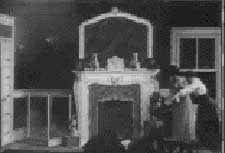 One of Porter's funniest mini-comedies is The Burglar's Slide for Life (1905). A burglar enters through the door stage right & begins looking about the living-room for something worth taking. He's forced to hide behind a space heater's screen in the corner when two women arrive.
One of Porter's funniest mini-comedies is The Burglar's Slide for Life (1905). A burglar enters through the door stage right & begins looking about the living-room for something worth taking. He's forced to hide behind a space heater's screen in the corner when two women arrive.
The ladies unknowingly set the burglar on fire. Smoking & hopping & rolling on the floor to put himself out, he leaps up & runs for the window. It is in an upper floor apartment, so he must make his escape across a pulley-driven zigzag of clotheslines that span the alley.
The family bulldog (the famous Mannie who played Tige in The Buster Brown Series) goes after him, clinging by its mighty jaws to an item of clothing on the clolthesline.
The clothesline zigzags from pulley to pulley down the alley to each window that needs a line to dry clothing. The thief & the dog both go zipping along on the ropes, the thief knocking hanging clothes loose as he goes, & people appearing at windows to chuck stuff at him.
When dog & thief have zigzagged all the way to the courtyard below, the dog jumps down first, then leaps up a couple times to bite the dangling thief, who eventually drops to the ground & makes an attempt to get over the fence.
The dog is attached to his britches, & a woman runs into the courtyard with a broom for weapon to help the dog make life a misery for the burglar. Others from the bulding join in until all havoc & violence is laid upon him.
Approaching six minutes, which is quite long for a film of this era, the filmmakers clearly understood they'd lit upon a very innovative idea & milked it for all its was worth.
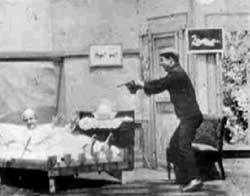 It is perhaps the same luckless cat-burglar who breaks into the apartment of Subub in Subub Surprises the Burglar (1903). If so, this was probably to be his last crime this side of Hades.
It is perhaps the same luckless cat-burglar who breaks into the apartment of Subub in Subub Surprises the Burglar (1903). If so, this was probably to be his last crime this side of Hades.
A burglar steps through a window into a bedroom scene. Checking that the sleeper really sleeps, the burglar begins to rifle through a chest of drawers & Subub's pants pockets.
Subub is roused from slumber, discovering he's being robbed. The robber points his pistol at Subub, who responds by putting thumb on nose & waggling his fingers.
While thus blowing the criminal a raspberry, his murphy bed folds up into the wall with him in it, & mounted on the underside of the bed's frame are guns which automatically shoot the burglar.
The housebreaker inexplicably vanishes in a puff of smoke. The murphy bed lowers & Subub hops & dances happily on the room.
A trick film, Another Job for the Undertaker (1901) doesn't quite make sufficient sense. It's a "rube" comedy about a bumpkin away from home.
A bellboy brings the man to his rented room. The boy then sommersaults & disappears. The gent sets down his umbrella & satchel & they too promptly vanish, as does the jacket he's wearing. He seems properly alarmed but not sufficiently so to get out of the weird room.
He takes off his boots & they come alive. The chair he's about to sit in disappears as he attempts to sit in it. As he sommersaults backward, the rest of his clothes vanish & he's been given nightclothes by the mysterious trickster.
Instead of fleeing in terror, he attempts to blow out the gas lamp on the wall, despite a sign that says "Do Not Blow Out the Gas." He then gets into bed to spend the night. The scene then cuts to the street, with a horse-drawn undertaker's wagon driving by.
The implications are not entirely clear but very likely by blowing out the gas he insured his own death in the night, though how this relates to the trick-film haunting escapades, beats me, let alone how this is a suitable ending for something otherwise a comedy.
copyright © by Paghat the Ratgirl
|
